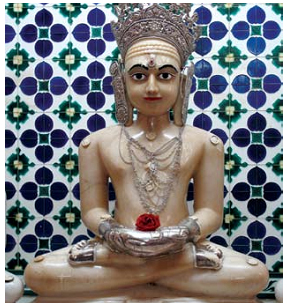
Centre of Jaina Studies Newsletter: SOAS - University of London
Religious discourse in South Asia is dominated by the telling of stories, very often life histories. Alongside doctrinal explanations, cosmological enumerations, and descriptions of practice, are many concrete examples in the form of biographical narratives. In discussions of karma, rebirth, and ethics, no examples can be more helpful than stories of people whose actions have brought about results in subsequent lives.
Buddhism and Jainism share the concepts of karma, rebirth, and the possibility (and desirability) of escape from rebirth, though each has a different interpretation of these key ideas. Within the literature of both traditions we find many stories about remembered past births, illustrating progress on the path to liberation, the workings of karma, and the jumbled nature of rebirth. These stories have much to reveal about Buddhist and Jain attitudes towards the mechanisms of rebirth and the pursuit of longterm (multi-life) religious goals.
During a three-year project funded by the British Academy (2009-12), I will compare birth stories from the Jain and Buddhist traditions in relation to the role of karma in rebirth, the key religious paths and goals, and the role of birth stories in the teaching careers of awakened beings. The aim of the project is to ascertain the distinctively Buddhist and Jain uses of this genre, thereby illuminating the significance of the stories within each tradition, as well as contributing to our understanding of the extent of interaction between Buddhist and Jain schools during their formative periods.
The first year of the project will primarily be spent surveying the sources and identifying both key generic characteristics and individual stories of interest. I am in the process of creating annotated bibliographies for birth stories in Jain and Buddhist scriptures and later sources. These will be posted on the internet for the use of other interested scholars: http://blogs.cf.ac.uk/birthstories. I would of course be very grateful for any comments or additions.
Having identified the most significant sources I will begin analysing the key themes, which are likely to include: (i) The mechanism of karma and rebirth, including the bonds that tie people together through several lives, and the extent to which characteristics (e.g. species, gender) and relationships are preserved across different lives; (ii) How stories about previous births of Buddhas and Jinas contribute to biographical, historical, and exemplary narratives; (iii) The significance of this form of memory, in other words the restrictions on who can remember their past births, the circumstances that prompt them to do so, and what actions the memories prompt. In relation to the last theme, it will be necessary to address the gender divide as well as the division between lay and monastic lifestyles. For example, it will be of interest to know whether or not women and laypeople are shown remembering their past births, and the extent to which their reasons for remembering and narrating their previous births are different to those of monks.
Several stories of rebirth are found in both Jain and Buddhist versions. Whilst the aim of this project is not to compare different versions of specific stories, an example might here help to illustrate some of the key themes of the research.

Statue of the female Tīrthaṅkara Mallinātha in the Śvetāmbara temple in Jaṃḍiyālā/Pañjāb. Mallinātha's past birth as a man who cheated in his ascetic practices is the well-known cause of her female state (in the Śvetāmbara tradition). Photo: Peter Flügel 2009
In the Vimānavatthu, or 'Stories of the Heavenly Mansions,' (the sixth book of the Khuddaka-nikāya of the Theravāda scriptures) we find narrations of the past deeds of gods, usually acts of generosity, which resulted in their birth in heavenly mansions. In chapter fifty-one we find the story of a frog that is delighted to hear the Buddha giving a sermon, but is killed in the process. The frog is reborn as a god quickly enough to return to the area to catch the end of the teaching and reveal his past birth to the assembled people. In chapter thirteen of the Jñātādharmakathāṅga Sūtra we find another story about a frog. A man meets Mahāvīra and becomes a lay follower. Later, as a result of not meeting any more ascetics, he lapses in his practices. He conceives a strong desire to build a lovely pool outside the city. With much effort, he begins construction of the pool, complete with gardens and all other proper facilities. Everyone is very pleased and grateful, but he becomes so attached to this pool that when he dies he is reborn as a frog in the water. He hears people around the pool praising his past self, and in a state of concentration he attains memory of his past birth. Shocked at his descent to the position of frog, he takes the twelve lay vows and begins performing penances. During this time he hears that Mahāvīra is staying nearby and so he tries to make his way to hear a sermon. Whilst hopping along a crowded street he is trampled by the king's horse, and dies with his mind on his vows and the omniscient ones. As a consequence he is reborn as a god. Later he will be reborn in Mahāvideha and attain mokṣa there.
These stories are both about a frog who is in a good state of mind brought about by hearing, or striving to hear, a sermon, and thus is reborn in a divine realm when he is unluckily (and ignominiously) killed. From these stories we can see that the state of mind one is in at the time of death is important to both traditions, as is the assumed power of hearing the teachings; the latter is arguably the focus of the Buddhist version. Animals are shown as capable of concentration and, in the Jain case, of penances and ascetic practice. The rebirth of a frog as a god is not a complete enough narrative for the Jain composers, though, who have two extra layers: the preceding birth as a man, and the subsequent birth as an ascetic. The first layer illustrates the shocking effects of attachment, again with an emphasis upon the moment of death. The second confirms the eventual liberation of the frog, providing a complete happy ending and ensuring that the focus is upon the spiritual progress of the hero. In contrast to the Vimānavatthu's simple promise of divine birth to good lay Buddhists, the Jñātādharmakathāṅga story highlights the Jain ideal that the lay path should culminate in the ascetic path, whatever deviations there might be on the way.
The different conceptions of past birth memory are also well illustrated in these stories. In the Buddhist case the god narrates his past birth to the Buddha and his audience, though the Buddha has already predicted the events of the story. The Buddha's superior vision is thereby praised, whilst gods are also shown as having an awareness of their past abodes. In the Jain case, however, even a frog is shown as having an innate knowledge of his past births, if only the circumstances are favourable. His memory of his past birth is enabled by being in familiar surroundings, hearing people mention his former self, and attaining a pure state of concentration; these circumstances are familiar from many other Jain narratives. The overall story is narrated by Mahāvīra, who of course knows everything, yet it also suggests the possibilities and benefits open to all other beings, whose destinies may be dramatically affected by gaining an awareness of their previous lives. This situation can be contrasted with the Buddhist understanding that memory of past births is the result of extensive meditative practice or birth in a heaven realm.
There is much more that could be said about these stories, but I hope that this example has begun to demonstrate the richness of birth stories as sources, and the potential interest of the project's research findings to Jainologists and Buddhologists alike.
Naomi Appleton's love of rebirth narratives began as an undergraduate and led her to complete two theses (M.Phil. Cardiff 2004; D.Phil. Oxford 2008) about stories of the past births of the Buddha. She is currently the holder of a British Academy Post-Doctoral Fellowship at the School of Religious Studies, Cardiff University
 Dr. Naomi Appleton
Dr. Naomi Appleton